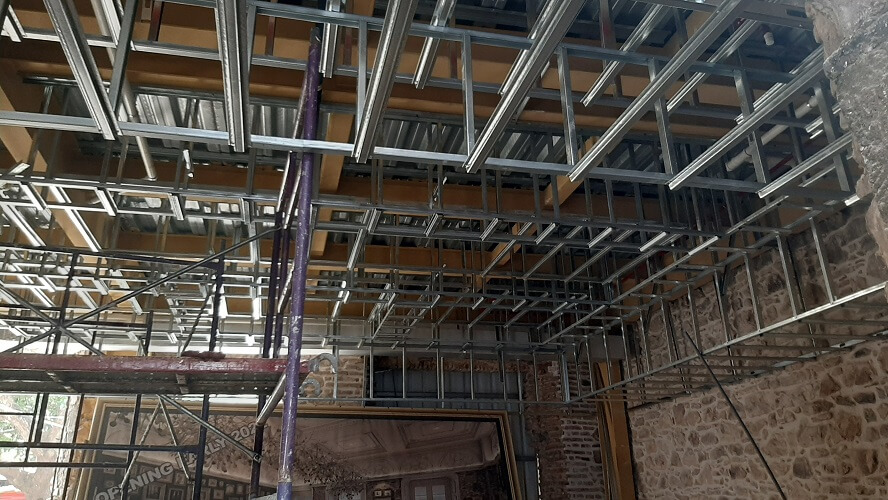We have previously shared articles about the benefits of lightweight systems on construction sites. Reviewing a bit, we consider of great value the delivery times and costs they provide, the order and cleanliness they allow during the execution of the project, the versatility that the system allows with a cleaner finish and its easy access when you need to do make repairs.
Now, to take advantage of all the benefits that these systems offer, it is important to select companies with vast experience in their installation, since mistakes can be made that would represent delays and additional costs. For this reason, below we share with you the five errors that we believe are important to pay attention to in order to avoid mistakes associated to light wall installations:
- Not knowing the system to use, the spacing in the structure and screws, the classification of finish levels, its type of sheet and, of course, the appropriate use for each of them. Failure to use a correct installation according to the type of sheet can cause cracks at the time of installation;
- Not being clear about the types of finishes and materials to be installed on the light system from the beginning of the work;
- Not considering the thickness of the materials to be installed inside the lightweight wall will also generate errors at the time of the finishings. For example, not considering the size of the pipes inside the walls, as well as the layout of light walls that are often carried out with inadequate architectural plans;
- Not using tools that guarantee a good leveling of the structure and sheets, such as the use of a laser, level, plumb lines, rulers, and squares. For example, when checking plumbing and leveling of plastered walls, avoid detecting erroneous unevenness, something that happens a lot in the corners where the plastic corner pieces are placed; and
- Having a poor disposal and storage of the material can also cause damage to them and affect the final finishing in the future as a result of rusty metals, warped sheets, broken and/or wet sheets.
Our recommendations to avoid mistakes:
→ Define in previous stages the type of system and indicate it from the development of the plan, indicate the correct thickness of the walls, considering the dimensions of the pipes which depend on the electromechanical networks required;
→ Have the details of pipe reinforcements and transitions according to the recommendations of the manufacturers and suppliers. If they are carried out according to these details, no cuts should be generated in the structures;
→ Be clear that the plastic corners generate a thickness that in turn generates an unevenness, so the squares must be verified before placing the plastic corners to avoid unevenness in the final finishing. As well as applying the light in the final incidence of the area; that is, simulate the lamp that will finally be installed;
→ Have a training system supported by system providers, where both construction personnel and supervisors are instructed, prior to the start of installations; and
→ Provide follow-up and assurance on the part of all those involved for compliance with what is established in the system manuals, ensure the correct installation, as indicated.
These simple points and ensuring the involvement of all parties in early stages, have been the success of good management of light systems, providing a reduction in time and costs to benefit our projects.



return
share in:
return
share in:
return
share in:
Recommended reading
Getting to know Carlos Gonzalez
Jun
Importance of having an expert advisor in finishes
Jun
How to define if your project is feasible?
May
Efficiencies in earthworks
May
Getting to know Aura Quintana
Apr
Project permits
Apr
Leap to technology: integration and efficiency
Mar
What is a Test Fit?
Mar
Getting to know Jonahan Castillo
Feb
Importance of involving an electromechanic in a project
Feb
Sofitel Legend Casco Viejo, a unique experience in Panama
Jan
Our 2022 summary
Jan
Getting to know Digna Olivardia
Dec
Our experience with post-tensioned slabs
Nov
The different phases of the design service at Mar Azul
Nov
Multifunctional spaces
Oct
Getting to know Salomón Dayán
Oct
Importance of a proper technical inspection
Sep
Which sustainable certification to choose and which is the most suitable for my project?
Aug
Hotel La Compañía, our execution experience in an important historical area
Aug
Getting to know Leydis Moreno
Jul
Cost management
Jul
Responsible recycling
Jun
Welcome Back Engineer José Ramón Icaza
Jun
Getting to know Jorge Silva
May
Five steps to create a project plan
May
Recommendations for working with natural stones
Apr
Administration vs. Project management
Apr
Getting to know Teresa Perez
Mar
Five common mistakes in the installation of lightweight walls and how to avoid them
Mar